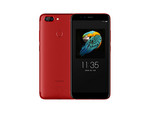Lenovo S5
Specifications

Secondary Camera: 16 MPix f/2.2
Price comparison
Average of 3 scores (from 4 reviews)
Reviews for the Lenovo S5
Source: Chinahandys.net
 DE→EN Archive.org version
DE→EN Archive.org versionSingle Review, online available, Long, Date: 12/02/2018
Rating: Total score: 77% performance: 70% display: 70% mobility: 70% workmanship: 100%
Source: ChinaMobileMag
 DE→EN Archive.org version
DE→EN Archive.org versionSingle Review, online available, Long, Date: 05/14/2018
Source: Xataka
 ES→EN Archive.org version
ES→EN Archive.org versionSingle Review, online available, Long, Date: 06/07/2018
Rating: Total score: 82% performance: 80% display: 80% mobility: 70% workmanship: 100%
Source: Chimera Revo
 IT→EN Archive.org version
IT→EN Archive.org versionSingle Review, online available, Long, Date: 01/27/2019
Rating: Total score: 75%
Comment
Model:
Remember the days when Lenovo owned Motorola? I do. They bought it, sold it, said they were leaving the smartphone business or something similar to that, and voilà, they are back at it again.
I can not say they are looking to be competitive, because in today’s market, while the decline in notebook and PC sales is still on-going, there is a huge shift in the smartphone business. Whether you are Lenovo or someone else, unless you are truly specialized in the PC business (such as Gigabyte, MSI), you need new areas for growth. In my thinking, this is what Lenovo is trying to achieve.
The Lenovo S5, from the first moment of unboxing, gives you the impression of a low mid-range phone. Low, because of the plastic case. Mid because, well, it has dual cameras, a fingerprint sensor on the back, no headphone jack, etc.
The main issue, and the reason for the low-end feeling, is that all the surfaces are fingerprint magnets. The rear cover is easy to scratch. I mean, workmanship, this is what is lacking.
Hardware-wise, there are two variants. In terms of the processor, both are the same, equipped with a Snapdragon 625. Then 3 GB of RAM with 32 GB of ROM or 4 GB of RAM with 64 GB of ROM.
I am trying to find something special that could differentiate it from the competition, but as I said, this literally looks like an effort to exist in the smartphone market. The device looks pretty similar to the Xiaomi Mi 5X, maybe you could say it has similar hardware to the Huawei P20 Lite, but in terms of haptics, it is far away from it - the Huawei P20 Lite is, in simple terms, very beautiful. The Lenovo S5? No.
So, why on earth would you buy this phone? Well, it is cheap. Starting around 175-200$, it comes with stock Android 8.0, so it is up to date. That is it.
Now, with all my reviews, would I buy this, or would I buy this phone for my mum? For my mum, yes. For myself, I am in doubt. For me, what matters is audio quality, usability. Audio quality is a question with this device. Other than that, I can use it for checking email and browsing. If you spend too much time on the phone talking, then it is not for you.
Do I give it a thumbs up? Nope. Check for other options in this price range, and then decide what suits you better.
Hands-on article by Umit Yilmaz Gunes
Qualcomm Adreno 506: Integrated graphics card in the Snapdragon 625 SoC and based on the new 500-series architecture with support for Vulkan, OpenGL ES 3.1 + AE (3.2) and UBWC.
Only some 3D games with very low demands are playable with these cards.
» Further information can be found in our Comparison of Mobile Graphics Cards and the corresponding Benchmark List.
625: Mid-range octa-core SoC with eight ARM Cortex-A53 cpu cores at up to 2 GHz, an Adreno 506 GPU, a DDR3L-1866 memory controller and a X9 LTE (Cat 7) modem. Manufactured in the modern 14nm process.» Further information can be found in our Comparison of Mobile Processsors.



